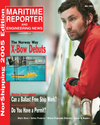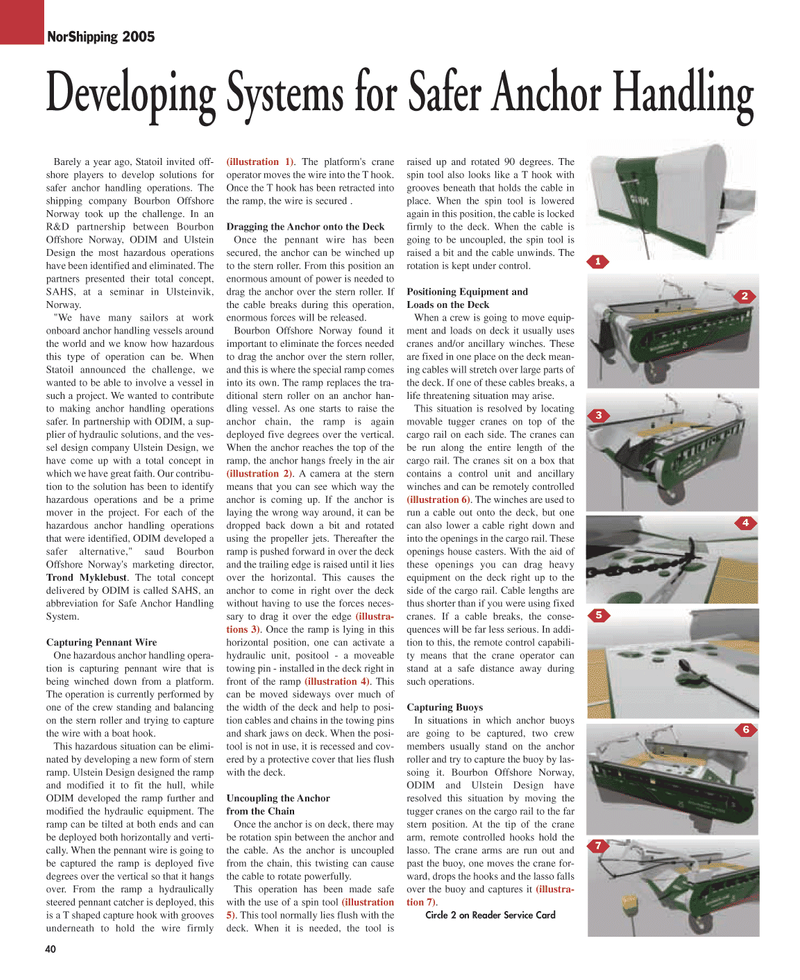
Page 40: of Maritime Reporter Magazine (May 2005)
Marine Enviroment Edition
Read this page in Pdf, Flash or Html5 edition of May 2005 Maritime Reporter Magazine
40
Barely a year ago, Statoil invited off- shore players to develop solutions for safer anchor handling operations. The shipping company Bourbon Offshore
Norway took up the challenge. In an
R&D partnership between Bourbon
Offshore Norway, ODIM and Ulstein
Design the most hazardous operations have been identified and eliminated. The partners presented their total concept,
SAHS, at a seminar in Ulsteinvik,
Norway. "We have many sailors at work onboard anchor handling vessels around the world and we know how hazardous this type of operation can be. When
Statoil announced the challenge, we wanted to be able to involve a vessel in such a project. We wanted to contribute to making anchor handling operations safer. In partnership with ODIM, a sup- plier of hydraulic solutions, and the ves- sel design company Ulstein Design, we have come up with a total concept in which we have great faith. Our contribu- tion to the solution has been to identify hazardous operations and be a prime mover in the project. For each of the hazardous anchor handling operations that were identified, ODIM developed a safer alternative," saud Bourbon
Offshore Norway's marketing director,
Trond Myklebust. The total concept delivered by ODIM is called SAHS, an abbreviation for Safe Anchor Handling
System.
Capturing Pennant Wire
One hazardous anchor handling opera- tion is capturing pennant wire that is being winched down from a platform.
The operation is currently performed by one of the crew standing and balancing on the stern roller and trying to capture the wire with a boat hook.
This hazardous situation can be elimi- nated by developing a new form of stern ramp. Ulstein Design designed the ramp and modified it to fit the hull, while
ODIM developed the ramp further and modified the hydraulic equipment. The ramp can be tilted at both ends and can be deployed both horizontally and verti- cally. When the pennant wire is going to be captured the ramp is deployed five degrees over the vertical so that it hangs over. From the ramp a hydraulically steered pennant catcher is deployed, this is a T shaped capture hook with grooves underneath to hold the wire firmly (illustration 1). The platform's crane operator moves the wire into the T hook.
Once the T hook has been retracted into the ramp, the wire is secured .
Dragging the Anchor onto the Deck
Once the pennant wire has been secured, the anchor can be winched up to the stern roller. From this position an enormous amount of power is needed to drag the anchor over the stern roller. If the cable breaks during this operation, enormous forces will be released.
Bourbon Offshore Norway found it important to eliminate the forces needed to drag the anchor over the stern roller, and this is where the special ramp comes into its own. The ramp replaces the tra- ditional stern roller on an anchor han- dling vessel. As one starts to raise the anchor chain, the ramp is again deployed five degrees over the vertical.
When the anchor reaches the top of the ramp, the anchor hangs freely in the air (illustration 2). A camera at the stern means that you can see which way the anchor is coming up. If the anchor is laying the wrong way around, it can be dropped back down a bit and rotated using the propeller jets. Thereafter the ramp is pushed forward in over the deck and the trailing edge is raised until it lies over the horizontal. This causes the anchor to come in right over the deck without having to use the forces neces- sary to drag it over the edge (illustra- tions 3). Once the ramp is lying in this horizontal position, one can activate a hydraulic unit, positool - a moveable towing pin - installed in the deck right in front of the ramp (illustration 4). This can be moved sideways over much of the width of the deck and help to posi- tion cables and chains in the towing pins and shark jaws on deck. When the posi- tool is not in use, it is recessed and cov- ered by a protective cover that lies flush with the deck.
Uncoupling the Anchor from the Chain
Once the anchor is on deck, there may be rotation spin between the anchor and the cable. As the anchor is uncoupled from the chain, this twisting can cause the cable to rotate powerfully.
This operation has been made safe with the use of a spin tool (illustration 5). This tool normally lies flush with the deck. When it is needed, the tool is raised up and rotated 90 degrees. The spin tool also looks like a T hook with grooves beneath that holds the cable in place. When the spin tool is lowered again in this position, the cable is locked firmly to the deck. When the cable is going to be uncoupled, the spin tool is raised a bit and the cable unwinds. The rotation is kept under control.
Positioning Equipment and
Loads on the Deck
When a crew is going to move equip- ment and loads on deck it usually uses cranes and/or ancillary winches. These are fixed in one place on the deck mean- ing cables will stretch over large parts of the deck. If one of these cables breaks, a life threatening situation may arise.
This situation is resolved by locating movable tugger cranes on top of the cargo rail on each side. The cranes can be run along the entire length of the cargo rail. The cranes sit on a box that contains a control unit and ancillary winches and can be remotely controlled (illustration 6). The winches are used to run a cable out onto the deck, but one can also lower a cable right down and into the openings in the cargo rail. These openings house casters. With the aid of these openings you can drag heavy equipment on the deck right up to the side of the cargo rail. Cable lengths are thus shorter than if you were using fixed cranes. If a cable breaks, the conse- quences will be far less serious. In addi- tion to this, the remote control capabili- ty means that the crane operator can stand at a safe distance away during such operations.
Capturing Buoys
In situations in which anchor buoys are going to be captured, two crew members usually stand on the anchor roller and try to capture the buoy by las- soing it. Bourbon Offshore Norway,
ODIM and Ulstein Design have resolved this situation by moving the tugger cranes on the cargo rail to the far stern position. At the tip of the crane arm, remote controlled hooks hold the lasso. The crane arms are run out and past the buoy, one moves the crane for- ward, drops the hooks and the lasso falls over the buoy and captures it (illustra- tion 7).
Circle 2 on Reader Service Card
NorShipping 2005
Developing Systems for Safer Anchor Handling 1 2 3 4 5 6 7
MR MAY 2005 #5 (33-40).qxd 5/2/2005 9:16 PM Page 40

 39
39

 41
41
